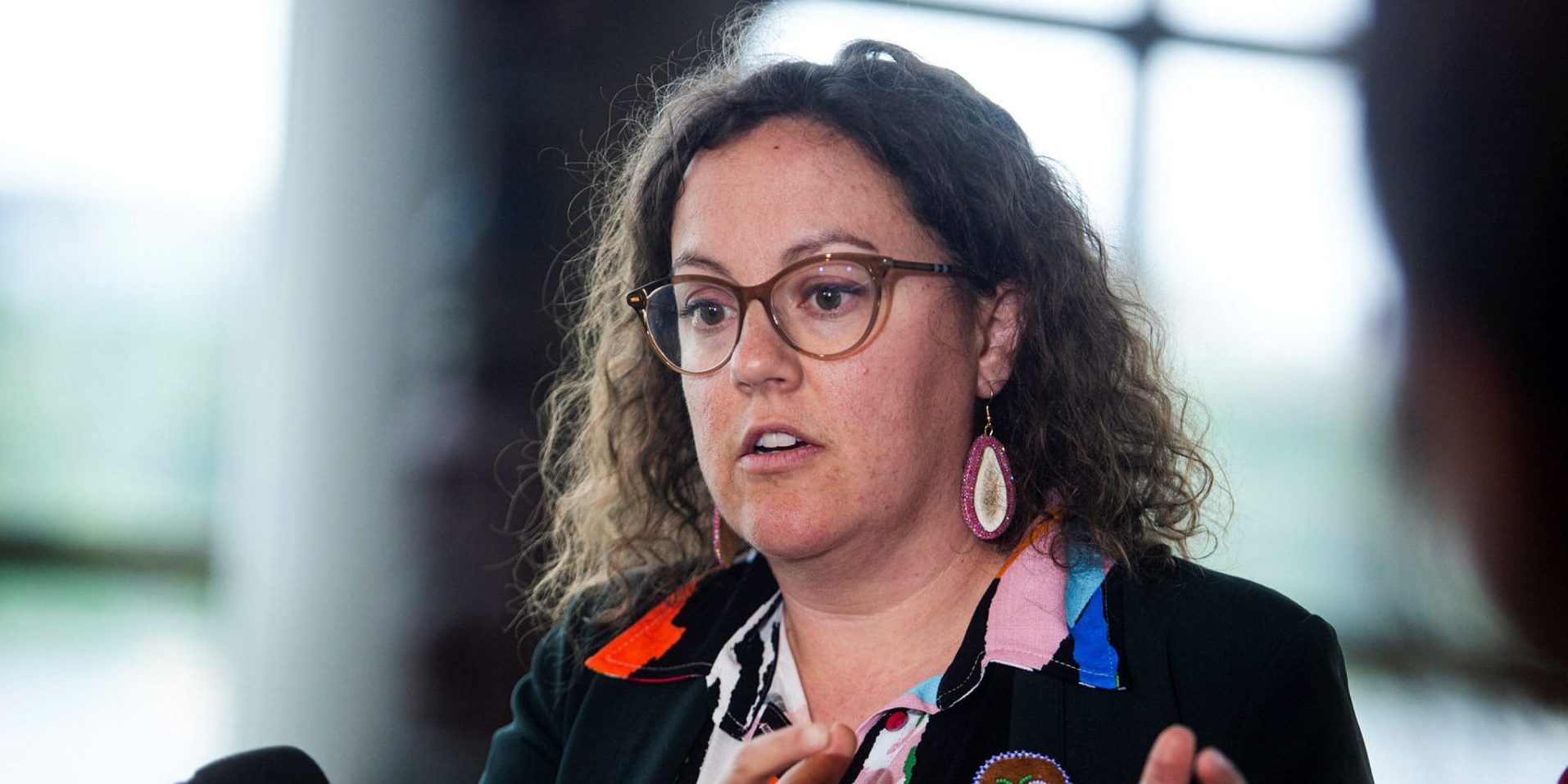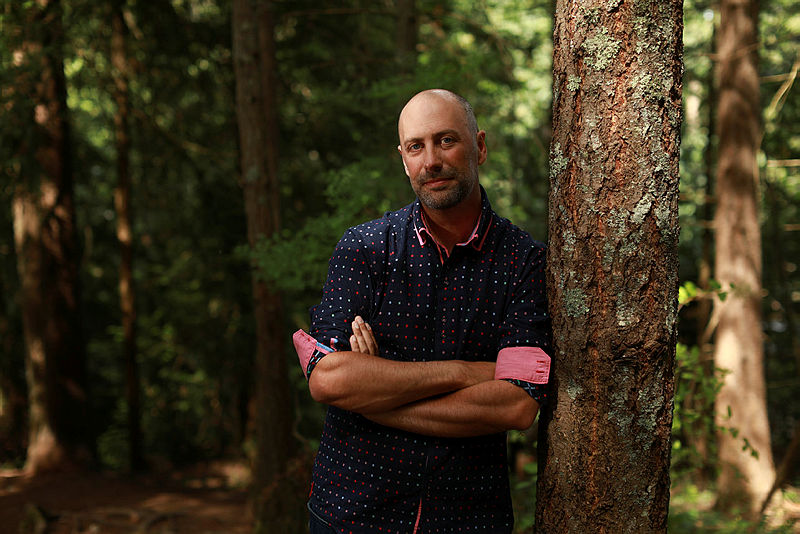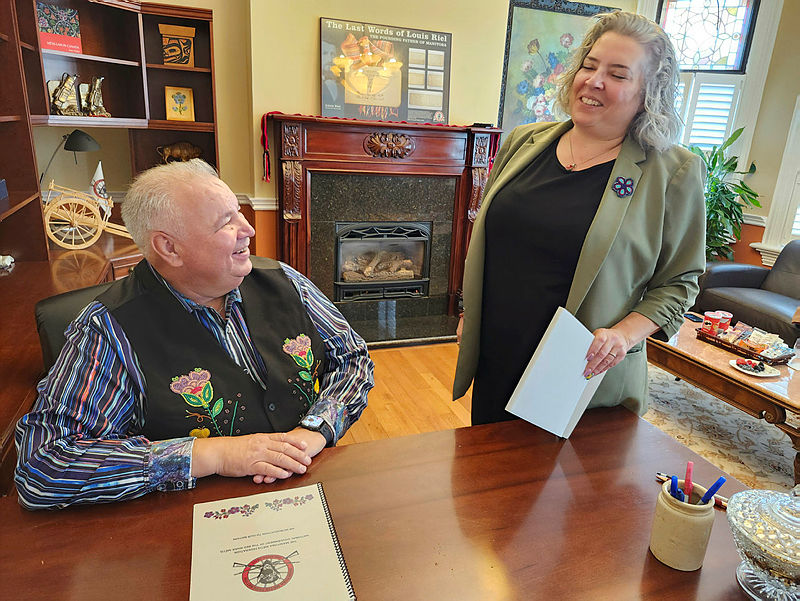‘Keep that nation-to-nation concept strong,’ say Indigenous leaders, as Canada moves on major projects

As Canada begins prioritizing the economy and nation-building projects in the wake of a trade war with the United States, Indigenous advocates and leaders argue that an important aspect of reconciliation includes keeping an open dialogue.
“The most important priority is to keep the conversation of reconciliation alive and central in the discussions that are unfolding at the national level and across the country right now,” said Ry Moran, associate university librarian for reconciliation at the University of Victoria, and a former director of the National Centre for Truth and Reconciliation.
“There’s a lot of talk about building Canada … [and] about generational investments, and I think what’s so critical right now is that we don’t forget that investing substantially and thoroughly and deeply into the work that has been outlined by the TRC [Truth and Reconciliation Commission] is the generational change that is actually necessary if we’re serious about moving towards respectful and sustainable futures in Canada.”
The National Day for Truth and Reconciliation is Sept. 30. Moran, a member of the Red River Métis, argued that as Canada moves forward with major projects, that this work is seen through the lens of the United Nations Declaration on the Rights of Indigenous Peoples, which he said includes the concepts of free, prior and informed consent.
Prime Minister Mark Carney (Nepean, Ont.) launched the new Major Projects Office (MPO) on Aug. 29, intended to serve as a single point of contact to get nation-building projects built faster. The office is supported by an Indigenous Advisory Council, with members including Kluane Adamek, a former Assembly of First Nations (AFN) Yukon Regional Chief; and Chief Darcy Bear of the Whitecap Dakota First Nation in Saskatchewan.

“As an observer, it does seem that things are moving at an extremely fast pace, and that’s necessary sometimes. However, moving quickly doesn’t mean jumping over or bypassing or skirting very hard fought for, and now some pretty long-standing principles that we have established in Canada around how we ought to be approaching these projects together, between Indigenous and non-Indigenous peoples,” said Moran.
“We have to remember that adopting the principles inside of UNDRIP prevent harms from occurring, which in fact, allow us to go faster in the future, because we’re not making the same mistakes over and over again.”
The Hill Times reached out to the AFN to ask about reconciliation priorities, but an interview could not be arranged before deadline. National Chief Cindy Woodhouse Nepinak said that major project development “cannot happen without us,” and that “sustainable development requires respecting First Nations rights and including us as full partners in the determination of projects in the national interest,” in an AFN press release on July 22.
David Chartrand, president of the Manitoba Métis Federation (MMF), told The Hill Times that he considers the most important issue pertaining to reconciliation to be “not straying from this government-to-government recognition.”
“Keep that nation-to-nation concept strong. Preach it into your departments—that’s the new way. That’s the way we’re going to do business. It’s the way we’re going to make change, and we’re going to allow Indigenous people to choose their own fate,” he said.
The MPO was established following royal assent of the One Canadian Economy Act in June 2025. The legislation has drawn criticism from Indigenous chiefs across the country who are concerned the bill could be used to potentially bypass regulations such as the Impact Assessment Act, the Canada Energy Regulation Act, or the Indian Act in order to expedite projects deemed to be of national importance.
Chartrand told The Hill Times that he supports Bill C-5, but added that trust should go both ways.

“Canada has asked us to trust them, and that trust is hard. They’ve breached trust with us so many times,” he said.
“Here’s the key for me; if you’re asking us to trust you, you should have no problem signing legal documents to ensure that the promise you’re making is real and will be kept. That should be an easy task for any government, because I think we all will be working together to defend our country.”
He described the Red River Métis as an “economically driven people” who still “have the environment in the back of our minds.”
“Right now, we need to support Bill C-5. We just have to because it’s bigger than the Red River Métis. It’s about Canada. It’s about our country. We are at war, and we’ve got to take it seriously,” he said.
“I would encourage the Government of Canada … [if] we know the long-term effect to our villages [and how] communities could be impacted, then you’ve got to find a way to assure us that you’re going to fix that later. Ensuring that. Guarantee it’ll be fixed. But more importantly, guarantee us that we will understand fully … what the damage could be to the next generation, so we could be preparing ourselves.”
Chartrand and then-minister of Crown–Indigenous relations Gary Anandasangaree (Scarborough-Guildwood-Rouge Park, Ont.) signed a treaty on Nov. 30, 2024, recognizing the MMF as the government of the Red River Métis, with an inherent right to self-government and law-making powers over its more than 70,000 citizens, including for elections and other operations. The next step is to introduce federal legislation to bring the treaty into effect.
Chartrand said he hopes legislation for the treaty would be introduced in the fall. In regards to current Minister of Crown-Indigenous Relations Rebecca Alty (Northwest Territories), Chartrand said he doesn’t know her very well yet, but said “she’s trying. I’ll give her that.”
Chartrand said another reconciliation priority is resolving a land claim issues between Canada and the MMF.
As part of the agreement for Manitoba’s entry into Confederation, the Manitoba Act of 1870 set aside 1.4 million acres of land to be distributed among the Métis of the Red River Settlement. However, problems with the land distribution included delays, and insufficient land allotments that were often far from traditional Métis communities.
In 2013, the Supreme Court of Canada ruled that the federal Crown had failed to implement the land grant provision, establishing that the claim represents “unfinished business” for Métis people with Canadian sovereignty.
The November 2024 treaty includes paragraphs that commit the MMF and Canada to continue the government-to-government negotiations in regard to that land claim issue, according to an FAQ on the MMF website, adding that the MMF is “actively at the negotiation table with Canada to reach a land claim settlement.”
Chartrand said that former prime minister Justin Trudeau never delivered on promises to resolve the Métis land claim, but said he expects Alty and the current Liberal government to follow through.
In regard to whether Alty will follow through, Chartrand said he would “wait and see.”
“Trust me, I will hold her accountable. I will definitely be pushing our agenda, which a promise is a promise, and I’m a man of my word. If I give you a promise, I will never break that promise. I expect the same from this government. I expect the same from Alty.”
The Hill Times reached out to the Native Women’s Association of Canada (NWAC) to ask about reconciliation priorities and about Alty, but national president Josie Nepinak was not available before deadline.
Beth Dimsdale, NWAC’s chief operations officer, sent The Hill Times a statement by email, which criticized slow progress in the implementation of the 94 Calls to Action, the list of priorities released in June 2015 by the TRC intended to further reconciliation between Canadians and Indigenous Peoples. Slow implementation of the calls “demonstrates a continued failure to prioritize justice for Indigenous women in all their diversity,” according to the NWAC statement.
Beyond 94, a website that monitors progress on the TRC’s 94 Calls to Action, reported that 15 of the calls had been implemented by April 23, 2025, while 33 were listed as in progress with projects underway, 29 listed as in progress with projects only proposed, and 17 not yet started.
Call to Action 39 calls upon Ottawa to develop a national plan to collect and publish data on the criminal victimization of Aboriginal people, including data related to homicide and family violence victimization. While Beyond 94 lists Call to Action 39 as completed, the NWAC disagrees.
The NWAC argues that call remains incomplete, despite efforts by Statistics Canada to collect and publish data related to Indigenous victimization.
“NWAC asserts that existing data systems must be significantly expanded to capture the lived realities of Indigenous women. Data on Indigenous victimization must be disaggregated, distinction-based, trauma-informed, and publicly accessible,” reads the NWAC statement.
National Chief Brendan Moore, of the Congress of Aboriginal Peoples (CAP), told The Hill Times that a key reconciliation priority for him is the implementation of the “CAP-Daniels decision.”
In 2016, the Supreme Court established in Daniels versus Canada that the federal government has the jurisdiction to legislate about Métis and non-status Indians. The court held that Métis and non-status Indians—ethnically Indigenous people who do not have full Indian status under the Indian Act—are included in the term ‘Indian’ in Sec. 91 (24) of the Constitution.
The case was initiated by Harry Daniels, who was CAP president at the time.
Moore said that CAP has been excluded from the National Council for Reconciliation, an Indigenous-led independent body intended to advance reconciliation. The council was established through Bill C-29, the National Council for Reconciliation Act, which received royal assent on April 30, 2024. The AFN, Inuit Tapiriit Kanatami, the Métis National Council, and NWAC were all invited to nominate individuals for director positions.
“CAP was one of the organizations that were left off of the reconciliation Committee, which leaves out the majority of Indigenous peoples whenever it comes to having the capacity to have their advocates’ input on reconciliation,” said Moore.
“Reconciliation that leaves out off-reserve people isn’t reconciliation; it’s exclusion and enfranchisement dressed up in new clothes.”
In regard to Alty, Moore said she’s the first minister Crown-Indigenous Relations in years to meet with the Congress of Aboriginal people face to face.
“We have hope there. I’m always trying to build bridges, and hope that they’re looking to build bridges. We had a meeting last week with her and her team, and they felt very constructive,” he said.
“CAP has been representing these distinct people for over 50 years, and we need to be respected as the national Indigenous organization that we have been historically. She’s met with us, and so we’ll see what comes of that, but we have hope.”
Hillary Thatcher, managing director of Indigenous and Northern Investments for the Canada Infrastructure Bank (CIB), told The Hill Times that reconciliation and infrastructure are linked. Reconciliation means that communities get an opportunity to participate in talks about infrastructure, and that participation comes in many forms, she said.
“It can be actually building and owning and operating infrastructure in your community, but it can also be participating in the larger projects that are happening on your territory,” she said.
“Being able to create tools so that they can actively participate and benefit from those projects, it’s really about inclusion in the economic growth of this country … [and with] the major projects office, certainly, this government is certainly moving in that direction. When you create economic growth and it’s inclusive of those that have been left out, that’s reconciliation at its core.”
Thatcher said to help address the infrastructure gap facing Indigenous communities in Canada, the CIB created the Indigenous Community Infrastructure Initiative.
The CIB also set a target to invest at least $1-billion in revenue-generating Indigenous infrastructure projects. The office of the Parliamentary Budget Officer released data on July 10 which found that disbursements for Indigenous projects have already met that $1-billion target, and are expected to reach $3.1-billion by 2027-28.
The Hill Times
Editor’s note: This story was updated on Sept. 29 to indicate that the Red River Métis includes more than 70,000 registered citizens. This story previously said that there were more than 44,000.
Indigenous Infrastructure Gap Statistics
- First Nations lack essential infrastructure—housing, clean water, schools, healthcare, and roads—available to most Canadians. The gap is the estimated $349.2-billion investment needed to close these disparities by 2030. This includes $135.1-billion for housing, $5.2-billion for digital connectivity, and $208.9-billion for infrastructure.
- As of July 25, 2022, there were still 31 long-term and 14 short-term drinking water advisories in effect on 43 on-reserve communities across Canada, down from 105 in November 2015.
- Of an estimated 85,700 existing housing units, 34 per cent require minor repairs and 31 per cent require major repairs. An additional 108,803 housing units are needed to address overcrowding, replacement, and population growth.
- From 2020 to 2030, First Nations’ on-reserve population is expected to grow at an average rate of 1.7 per cent per year compared with only 1.0 per cent for the rest of Canada. Most building, utility, transportation, and housing infrastructure cannot accommodate such growth and requires immediate upgrading and long-term planning to ensure the continued functionality of on-reserve community infrastructure for First Nations.
Source: Closing the Infrastructure Gap by 2030, released in December 2023 by the Assembly of First Nations.






 LICENSING
LICENSING PODCAST
PODCAST ALERTS
ALERTS













